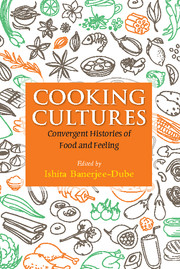Book contents
- Frontmatter
- Contents
- Acknowledgements
- Introduction: Culinary Cultures and Convergent Histories
- Part I Food, Pride, Power
- Part II Cooking, Cuisine, Gender
- 4 ‘Mem’ and ‘Cookie’: The Colonial Kitchen in Malaysia and Singapore
- 5 Modern Menus: Food, Family, Health and Gender in Colonial Bengal
- 6 Sweetness, Gender, and Identity in Japanese Culinary Culture
- Part III Food, Identity, Personhood
- Part IV Food, Myth, Nostalgia
- Contributors
- Index
- References
5 - Modern Menus: Food, Family, Health and Gender in Colonial Bengal
from Part II - Cooking, Cuisine, Gender
Published online by Cambridge University Press: 05 July 2016
- Frontmatter
- Contents
- Acknowledgements
- Introduction: Culinary Cultures and Convergent Histories
- Part I Food, Pride, Power
- Part II Cooking, Cuisine, Gender
- 4 ‘Mem’ and ‘Cookie’: The Colonial Kitchen in Malaysia and Singapore
- 5 Modern Menus: Food, Family, Health and Gender in Colonial Bengal
- 6 Sweetness, Gender, and Identity in Japanese Culinary Culture
- Part III Food, Identity, Personhood
- Part IV Food, Myth, Nostalgia
- Contributors
- Index
- References
Summary
A lamentable absence of order pervades our Bengal. This land lacks discipline and precision. This character of the Bengalis is particularly reflected in their food. The muddle of fish and milk-based dessert in our feasts results in a hodge-podge that is as contrary to the rules of scriptures as it is harmful for health. My prime objective is to save Bengali food from this disorderliness and confer on it order and discipline
This is how Prajñasundari Devi, one of the first woman authors of a Bengali cookbook, advertised the first volume of her book of vegetarian recipes published in 1900 (Devi, 1900).
Why had it become necessary for Prajñasundari, a writer and a member of the illustrious family of Tagores, to introduce order and discipline in Bengali cuisine at the turn of the twentieth century? Why had it become so important for her to publish this book of recipes? If we follow an article written almost nine decades later, cookbooks (or cookery books) are meant to reflect ‘shifts in the boundaries of edibility, the proprieties of the culinary process, the logic of meals, the exigencies of the household budget, the vagaries of the market, and the structure of domestic ideologies’ (Appadurai,1988, 3).
This chapter will focus on ‘the structure of domestic ideologies’ and the ‘exigencies of the household budget’ in conjunction with the notions of a healthy and modern cuisine to see how they shaped ‘proprieties of edibility’. Such ‘propriety of edibility’, I will argue, emerged in consonance with notions of healthy, nutritive and delicious food as a crucial marker of a ‘modern’ Indian (Hindu) family and a modern nation. The ‘Indian woman’, reconfigured by the elite nationalist discourse, as educated, accomplished and modern but totally dedicated to the care and wellbeing of the family, was conferred with vital importance as the caregiver and caretaker of the family.
An examination of the discourse on domesticity expressed in Bengali domestic manuals authored by men and cookbooks authored by men and women over the second half of the nineteenth century will serve to unpack the intricate links between imageries of the family and the nation kneaded together by allusions to health and beauty.
- Type
- Chapter
- Information
- Cooking CulturesConvergent Histories of Food and Feeling, pp. 100 - 121Publisher: Cambridge University PressPrint publication year: 2016
References
- 1
- Cited by



